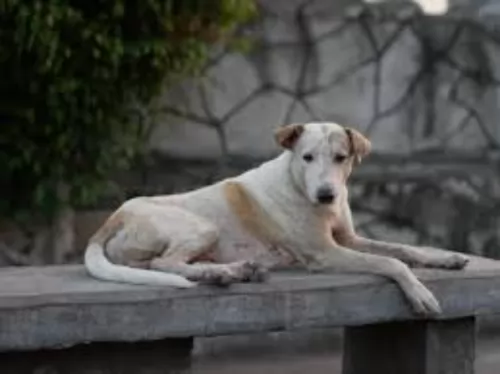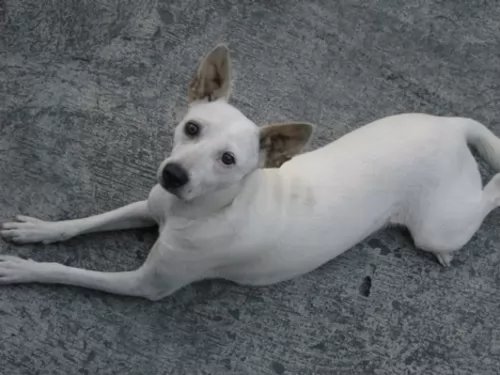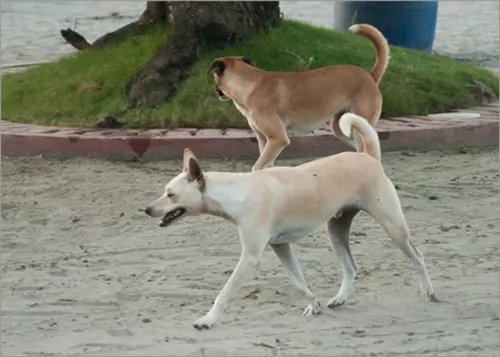 Petzlover
Petzlover Askal is originated from Philippines but Chinese Crested Dog is originated from Mexico. Askal may grow 40 cm / 16 inches higher than Chinese Crested Dog. Askal may weigh 24 kg / 53 pounds more than Chinese Crested Dog. Both Askal and Chinese Crested Dog has almost same life span. Both Askal and Chinese Crested Dog has almost same litter size. Both Askal and Chinese Crested Dog requires Low Maintenance.
Askal is originated from Philippines but Chinese Crested Dog is originated from Mexico. Askal may grow 40 cm / 16 inches higher than Chinese Crested Dog. Askal may weigh 24 kg / 53 pounds more than Chinese Crested Dog. Both Askal and Chinese Crested Dog has almost same life span. Both Askal and Chinese Crested Dog has almost same litter size. Both Askal and Chinese Crested Dog requires Low Maintenance.
 The Askal is a native dog of the Philippines where until fairly recently it was viewed condescendingly. As strays they have been slaughtered and dished up at the dinner table. Fortunately, campaigns have been launched to protect the dogs. The Askal has existed in the Philippines for centuries but the actual origin of the dogs is unknown. Some people speculate about the dogs, saying they look like the Dingo and must have descended from Australia’s native dog.
The Askal is a native dog of the Philippines where until fairly recently it was viewed condescendingly. As strays they have been slaughtered and dished up at the dinner table. Fortunately, campaigns have been launched to protect the dogs. The Askal has existed in the Philippines for centuries but the actual origin of the dogs is unknown. Some people speculate about the dogs, saying they look like the Dingo and must have descended from Australia’s native dog.
PAWS which is an animal Rescue and Re-homing, non-profit group encourages the use of the term Aspin for the dog as opposed to Askal and has had campaigns to promote the Aspin as a wonderful, local pet – loyal, robust and intelligent. In fact the Aspin Club has now been formed to give the dogs a club of their own and to promote the local breed.
 The Chinese Crested Dog is believed to have its origins in Africa and there are many texts from the 19th Century that feature an Africa Hairless Terrier that resembles the Chinese Crested. However, the scientific and genetic evidence leads to an origin that is shared with the Mexican Hairless Dog. Any way you look at it the dog did not originate in China. The Chinese were very fond of this breed and used them on their ships to control the rat populations. This is probably how they got their name.
The Chinese Crested Dog is believed to have its origins in Africa and there are many texts from the 19th Century that feature an Africa Hairless Terrier that resembles the Chinese Crested. However, the scientific and genetic evidence leads to an origin that is shared with the Mexican Hairless Dog. Any way you look at it the dog did not originate in China. The Chinese were very fond of this breed and used them on their ships to control the rat populations. This is probably how they got their name.
There are two types of Chinese Crested Dogs – the well known Hairless, and the lesser known Powderpuff. The Hairless type is better known because they carry the dominant trait and the Powderpuff is recessive. However, this recessive gene is carried by every Chinese Crested Dog so the Powderpuff can show up in all litters even those of two Hairless Crested. Two Powderpuffs will not result in any Hairless in their litters as the Powderpuff does not have the gene for the Hairless.
The “Crest Haven” Kennel was opened by Debora Wood in the 1950’s to breed the Chines Crested Dog. At the same time Gypsy Rose Lee, of the famous burlesque shows, was also breeding Chinese Crested Dogs. The two lines of Crested bred by Americans came together following the death of Rose Lee. Every Chinese Crested that lives today can trace their heritage directly to these two breeding lines. In 1959, Debra Wood founded the American Hairless Dog Club which became a part of the American Chinese Crested Club or the ACCC in 1978. This organization then became the breed’s parent club after AKC (American Kennel Club) recognized the breed in 1991. Prior to this the Federation Cynologique Internationale, recognized the breed in 1987, the United Kingdom (UK)the Kennel Club recognized them in 1981 and the Australian National Kennel Council recognized the Crested in 1995.
 Askals make awesome companions – intelligent and loving and their status is improving.
Askals make awesome companions – intelligent and loving and their status is improving.
Askals are now being trained to be bomb and narcotics sniffing dogs and it seems as though there are talks about making the Askal the national dog of the Philippines. They’re smart enough to train and socialize if you train them with patience and kindness.
They are medium-sized, feisty dogs with fairly long thin legs with short dense coats of many different colours. With their long, pointed muzzles and good, strong teeth, their ear shapes vary too, as some have pricked ears, while others have one pricked and one floppy ear.
The Askal will make a good watch dogs and he is protective with hisr human family, getting on well with children in the home, loving their energy and games.
 This is a toy breed and very small. The Hairless and the Powderpuff are two types of the same breed, although they do not look like it. The Hairless type can have fur anywhere on its body, but it will not have much. It will have hair on its paws, tail and head. The Powderpuff on the other hand will have a thick double coat. When discussing the color of the hairless, one is referring to the color of its skin. It can range from flesh to black.
This is a toy breed and very small. The Hairless and the Powderpuff are two types of the same breed, although they do not look like it. The Hairless type can have fur anywhere on its body, but it will not have much. It will have hair on its paws, tail and head. The Powderpuff on the other hand will have a thick double coat. When discussing the color of the hairless, one is referring to the color of its skin. It can range from flesh to black.
The Powderpuff has a soft, thick, straight double coat. It can have very long hair. The Hairless must have its skin taken care of and protected. Both types of Chines Crested are small in stature with well proportioned, athletic bodies.
 The Askal is an independent canine, street-smart and intelligent. He is a great pet for anyone who hasn't owned a pet before as he is low maintenance and undemanding.
The Askal is an independent canine, street-smart and intelligent. He is a great pet for anyone who hasn't owned a pet before as he is low maintenance and undemanding.
The Askal is intelligent and you won't have trouble teaching him some tricks and socializing him. He gets on well with children in the home as well as with other pets and his loyalty and devotion will ensure that he makes one hang of a companion.
He is just your 'dog next door', has no hang-ups and is simple to please. Be patient and kind to him and you'll be rewarded by having an awesome best friend.
Your Askal is wanting to be your unconditional friend through thick and thin. His undemanding, low maintenance character will mean that you won't be running to the vet with him all the time. Look after him well, include him as a member of the family and in exchange you'll have a wonderful best friend.
 Askals are healthy dogs because they are a mixed breed. The parents of a mongrel puppy have fewer genes in common than would be with a pure-bred mating. This is a distinct health advantage and mongrels are healthier and live longer than pure bred dogs. Street dogs have greater generic diversity and this gives them high resistance to many common dog illnesses.
Askals are healthy dogs because they are a mixed breed. The parents of a mongrel puppy have fewer genes in common than would be with a pure-bred mating. This is a distinct health advantage and mongrels are healthier and live longer than pure bred dogs. Street dogs have greater generic diversity and this gives them high resistance to many common dog illnesses.
The Askal is a tough, low maintenance dog that won’t cost you a lot of money in veterinary bills. Every Askal puppy will have to be taken to the vet to get his must-have vaccinations to protect him from killer dog diseases.
 The Chinese Crested Hairless version must have its skin take care of much in the same way we take care of our own. It will burn if exposed to too much sun without protection. They can suffer from dry skin, acne, need moisturizing cremes. They get skin allergies as well and it is important to take care of the skin instead of the brushing you don’t have to do.
The Chinese Crested Hairless version must have its skin take care of much in the same way we take care of our own. It will burn if exposed to too much sun without protection. They can suffer from dry skin, acne, need moisturizing cremes. They get skin allergies as well and it is important to take care of the skin instead of the brushing you don’t have to do.
The Chinese Crested does not suffer from most of the diseases other toy breeds do. They can have ye issues. The Hairless have a “primitive mouth” . They have pointy teeth and poor dentition. This is not true of the Powderpuffs however. Their eye issues include:
 the Askal is a low shedder and to keep him in tip-top condition will require you brushing his shor-haired coat twice a week.
the Askal is a low shedder and to keep him in tip-top condition will require you brushing his shor-haired coat twice a week.
Askals dogs are native Philippine dogs and aren’t difficult to feed. While you want to give your Askal the best quality food possible, they are unlike pure breed pedigrees and their stomachs are far more resilient to disease causing organisms that may upset the stomach. Having such a robust dog as a pet will cost you less in dog food as they can tolerate cheaper quality foods and left over scraps from the family table. Make sure the food you toss to him is fresh as you don’t want to take his strong stomach for granted and risk him getting sick. If you’re able to provide your Askal with hone cooked food, rice, vegetables and meat will be perfect for this wonderful pet of yours. Feeding your Askal will depend on your budget, but that’s the beauty with the Askal – it’s a dog that every dog-lover can own because this isn’t an exotic, expensive dog. Make sure he always has access to a bowl of clean, cool water.
The Askal has always roamed the Phillipine streets. Every dog will require some form of exercising and the Askal is no different. Take him for walks or play ball games with him to ensure he is stimulated and made to feel part of the family.
 Like several other toy breeds, it is easy to overfeed the Chinese Crested because it has such a small stature. Feed once or twice a day but never more than one fourth of a cup total for the day.
Like several other toy breeds, it is easy to overfeed the Chinese Crested because it has such a small stature. Feed once or twice a day but never more than one fourth of a cup total for the day.
Luxating Patellas – kneecaps move out of place and cause lameness and arthritis
Legg-Perthes Disease – a hip disorder where blood does not reach the head of the femur. The bone dies, and growth stops.
Canine Multiple System Degeneration (CMSD) – a progressive movement disorder can call falls
This Breed does not need an excessive amount of exercise, but they do enjoy running. They are competitive and athletic, so they can excel at flyball, lure coursing, agility and obedience. They are sensitive and trainable enough to become a therapy dog.